Class 10 - Mathematics
Triangles - Exercise 6.5

Top Block 1
Exercise 6.5
Question : 1:Sides of triangles are given below. Determine which of them are right triangles. In case of a right triangle, write the length of its hypotenuse.
(i) 7 cm, 24 cm, 25 cm (ii) 3 cm, 8 cm, 6 cm
(iii) 50 cm, 80 cm, 100 cm (iv) 13 cm, 12 cm, 5 cm
Answer :
(i) Sides of triangle are: 7 cm, 24 cm, 25 cm
Square these sides, we get 49, 576 and 625
Now, 49 + 576 = 625
⇒ 72 + 242 = 252
These sides satisfy the Pythagoras theorem; hence these are sides of right angled triangle.
Since hypotenuse is the longest side in right angle triangle. So, its length is 25 cm.
(ii) Sides of triangle are: 3 cm, 8 cm, 6 cm
Square these sides, we get 9, 64 and 36
Now, 9 + 36 ≠ 64
⇒ 32 + 62 ≠ 82
These sides do not satisfy the Pythagoras theorem; hence these are not sides of right angled triangle.
(iii) Sides of triangle are: 50 cm, 80 cm, 100 cm
Square these sides, we get 2500, 6400 and 10000
Now, 2500 + 6400 ≠ 10000
⇒ 502 + 802 ≠ 1002
These sides do not satisfy the Pythagoras theorem; hence these are not sides of right angled triangle.
(iv) Sides of triangle are: 13 cm, 12 cm, 5 cm
Square these sides, we get 169, 144 and 25
Now, 25 + 144 = 169
⇒ 52 + 122 = 132
These sides satisfy the Pythagoras theorem; hence these are sides of right angled triangle.
Since hypotenuse is the longest side in right angle triangle. So, its length is 13 cm.
Question : 2:PQR is a triangle right angled at P and M is a point on QR such that PM ⊥ QR.
Show that PM2 = QM . MR.
Answer :
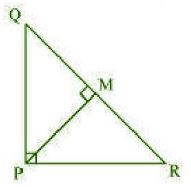
Now, in Δ MPR,
∠ MPQ = 90 – ∠ MPR = 90 – x
∠ MQP = 180 – 90 – (90 – x) = x
In Δ QMP and Δ PMR,
∠ MPQ = ∠ MRP
∠ PMQ = ∠ RMP
∠ MQP = ∠ MPR
So, Δ QMP ~ Δ PMR [AAA similarity]
We know that the corresponding sides of similar triangle are proportional
Therefore, QM/PM = MP/MR
⇒ PM2 = MQ * MR
Question : 3: In Fig. 6.53, ABD is a triangle right angled at A and AC ⊥ BD. Show that
(i) AB2 = BC . BD
(ii) AC2 = BC . DC
(iii) AD2 = BD . CD
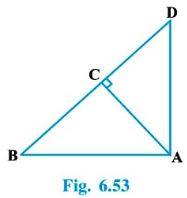
Mddle block 1
Answer :
(i) In Δ ADB and Δ CAB,
∠ DAB = ∠ ACB [Each 90]
∠ ABD = ∠ CBA [common]
So, Δ ADB ~ Δ CAB [AA similarity]
⇒ AB/CB = BD/AB
⇒ AB2 = CB * BD
(ii) Let ∠ CAB = x
Now, in Δ CBA,
∠ CBA = 180 – 90 – x
⇒ ∠ CBA = 90 – x
Similarly in Δ CAD,
∠ CAD = 90 –∠ CBA
⇒ ∠ CAD = 90 – x
∠ CDA = 180 – 90 – (90 – x)
⇒ ∠ CDA = x
In Δ CBA and Δ CAD,
∠ CBA = ∠ CAD [Proved]
∠ CAB = ∠ CDA [Proved]
∠ ACB = ∠ DCA [Each 90]
So, Δ CBA ~ Δ DCA [AAA similarity]
⇒ AC/DC = BC/AC
⇒ AC2 = BC * DC
(iii) In Δ DCA and Δ DAB,
∠ DCA = ∠ DAB [Each 90]
∠ CDA = ∠ ADB [Common]
So, Δ DCA ~ Δ DAB [AA similarity]
⇒ DC/DA = DA/DB
⇒ AD2 = BD * CD
Question : 4:ABC is an isosceles triangle right angled at C. Prove that AB2 = 2AC2.
Answer :
Given that the triangle ABC is an isosceles triangle such that
AC = BC and ∠ C = 90
In ΔABC, by Pythagoras theorem,
AB2 = AC2 + BC2
⇒ AB2 = AC2 + AC2 [Since AC = BC]
⇒ AB2 = 2AC2
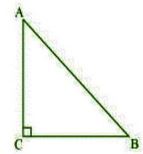
Question : 5:ABC is an isosceles triangle with AC = BC. If AB2 = 2 AC2, prove that ABC is a right triangle.
Answer :
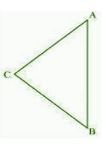
⇒ AB2 = AC2 + AC2
⇒ AB2 = AC2 + BC2 [Since AC = BC]
These sides satisfy the Pythagoras theorem.
Hence, the triangle ABC is a right angled triangle.
Question : 6:ABC is an equilateral triangle of side 2a. Find each of its altitudes.
Answer :
Let ABC be any equilateral triangle with each side of length 2a.
Now, draw perpendicular AD from A to BC.
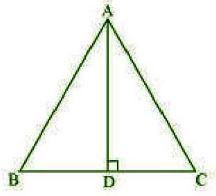
So, BD = DC = a
In Δ ADB, by Pythagoras theorem,
AB2 = AD2 + BD2
⇒ (2a)2 = AD2 + a2 [Since AB = 2a]
⇒ 4a2 = AD2 + a2
⇒ AD2 = 4a2 – a2
⇒ AD2 = 3a2
⇒ AD = a√3
Hence, the length of each altitude is a√3 unit.
Question : 7:Prove that the sum of the squares of the sides of a rhombus is equal to the sum of the squares of its diagonals.
Answer :
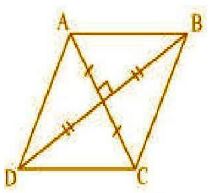
AB2 = AO2 + OB2 …………1
In Δ BOC, by Pythagoras theorem,
BC2 = BO2 + OC2 …………2
In Δ COD, by Pythagoras theorem,
CD2 = CO2 + OD2 …………3
In Δ AOD, by Pythagoras theorem,
AD2 = AO2 + OD2 …………4
Add equation 1, 2, 3 and 4, we get
AB2 + BC2 + CD2 + AD2 = AO2 + OB2 + BO2 + OC2 + CO2 + OD2 + AO2 + OD2
= 2[AO2 + OB2 + BO2 + OC2]
= 2[2AO2 + 2 OB2] [Since OA = OC, OB = OD]
= 4[AO2 + OB2]
= 4[(AC/2)2 + (BD/2)2] [Since OA = AC/2, OB = BD/2]
= 4[AC2/4 + BD2/4]
= AC2 + BD2
Question : 8:In Fig. 6.54, O is a point in the interior of a triangle
ABC, OD ⊥ BC, OE ⊥ AC and OF ⊥ AB. Show that
(i) OA2 + OB2 + OC2 – OD2 – OE2 – OF2 = AF2 + BD2 + CE2
(ii) AF2 + BD2 + CE2 = AE2 + CD2 + BF2.
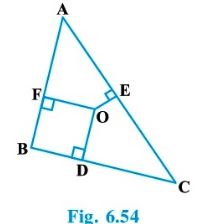
Answer :
Given, O is a point in the interior of a triangle ABC where OD ⊥ BC, OE ⊥ AC and OF ⊥ AB.
Join OA, OB and OC.
In Δ AOF, by Pythagoras theorem,
OA2 = OF2 + AF2 …………1
In Δ BOD, by Pythagoras theorem,
OB2 = OD2 + BD2 …………2
In Δ COE, by Pythagoras theorem,
OC2 = OE2 + EC2 …………3
Add equation 1 , 2 and 3, we get
OA2 + OB2 + OC2 = OF2 + AF2 + OD2 + BD2 + OE2 + EC2
⇒ OA2 + OB2 + OC2 – OD2 – OE2 – OF2 = AF2 + BD2 + EC2 ………4
(ii) From equation 4, we get
AF2 + BD2 + EC2 = OA2 + OB2 + OC2 – OD2 – OE2 – OF2
⇒ AF2 + BD2 + EC2 = (OA2 – OE2) + (OC2 – OD2)- (OB2 – OF2)
⇒ AF2 + BD2 + EC2 = AE2 + CD2 + BF2
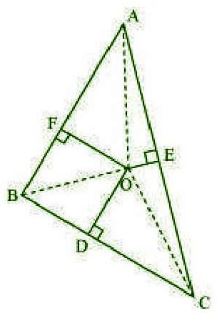
Question : 9:A ladder 10 m long reaches a window 8 m above the ground. Find the distance of the foot of the ladder from base of the wall.
Answer :
Let OA is wall and AB is ladder in the given figure.
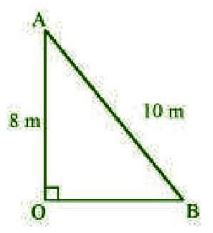
AB2 = OA2 + OB2
⇒ 102 = 82 + OB2
⇒ 102 = 64 + OB2
⇒ OB2 = 100 – 64
⇒ OB2 = 36
⇒ OB = 6
Hence, the distance of the foot of the ladder from the base of the wall is 6 m.
Question : 10:A guy wire attached to a vertical pole of height 18 m is 24 m long and has a stake attached to the other end. How far from the base
of the pole should the stake be driven so that the wire will be taut?
Answer :
Let OB is vertical pole in the given figure.
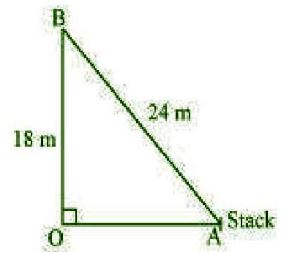
AB2 = OA2 + OB2
⇒ 242 = OA2 + 182
⇒ 576 = OA2 + 324
⇒ OA2 = 576 – 324
⇒ OA2 = 252
⇒ OA = √252
⇒ OA = 6√7
Hence, the distance of the stake from the base of the pole is 6√7 m.
Question : 11:An aeroplane leaves an airport and flies due north at a speed of 1000 km per hour.
At the same time, another aeroplane leaves the same airport and flies due west at a speed of 1200 km per hour.
How far apart will be the two planes after 1½ hours?
Answer :
Distance travelled by first aeroplane(due north) in 1½ hours = 1000 * 3/2
= 3000/2
= 1500 km
Distance travelled by second aeroplane(due north) in 1½ hours = 1200 * 3/2
= 3600/2
= 1800 km
Now, OA and OB are the distance travelled.
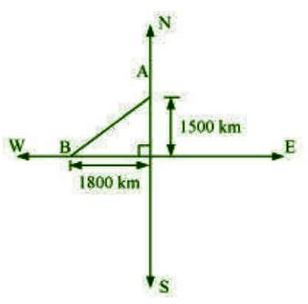
AB = √{OA2 + OB2}
⇒ AB = √{15002 + 18002}
⇒ AB = √{2250000 + 3240000}
⇒ AB = √5490000
⇒ AB = 300√61 km
Hence, in 1½ hours, the distance between two planes is 300√61 km.
Question : 12:Two poles of heights 6 m and 11 m stand on a plane ground. If the distance between the feet of the poles is 12 m,
find the distance between their tops.
Answer :
Let AB and CD are the two poles with height 6 m and 11 m respectively.
Therefore, CP = 11 – 6 = 5 m and AP = 12 m
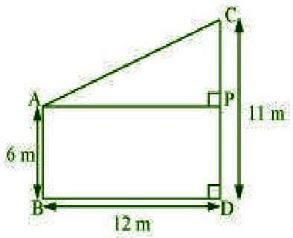
AC2 = AP2 + AC2
⇒ AC2 = 122 + 52
⇒ AC2 = 144 + 25
⇒ AC2 = 169
⇒ OA = √169
⇒ AC = 13
Hence, the distance between the tops of two poles is 13 m.
Question : 13:D and E are points on the sides CA and CB respectively of a triangle ABC right angled at C. Prove that AE2 + BD2 = AB2 + DE2.
Answer :
In Δ ACE, by Pythagoras theorem,
AC2 + CE2 = AE2 …………1
In Δ BCD, by Pythagoras theorem,
BC2 + CD2 = DB2 …………2
Add equation 1and 2, we get
AC2 + CE2 + BC2 + CD2 = AE2 + DB2 ………3
In Δ CDE, by Pythagoras theorem,
DE2 = CD2 + CE2 …………4
In Δ ABC, by Pythagoras theorem,
AB2 = AC2 + CB2 …………5
From equation 3, 4 and 5, we get
DE2 + AB2 = AE2 + DB2
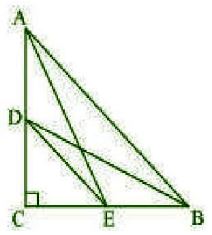
Question : 14:The perpendicular from A on side BC of a Δ ABC intersects BC at D such that DB = 3 CD
(see Fig. 6.55). Prove that 2 AB2 = 2 AC2 + BC2.
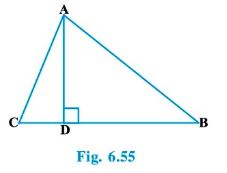
Answer :
In ΔACD, by Pythagoras theorem,
AC2 = AD2 + DC2
⇒ AC2 – CD2 = AD2 …………..1
In ΔABD, by Pythagoras theorem,
AB2 = AD2 + BD2
⇒ AB2 – BD2 = AD2 …………..2
From equation 1 and 2, we get
AC2 – CD2 = AB2 – BD2 …………3
Given, 3DC = DB, therefore
DC = BC/4 and BD = 3BC/4 …….4
From equation 3 and 4, we get
⇒ AC2 – (BC/4)2 = AB2 – (3BC/4)2
⇒ AC2 – BC2/16 = AB2 – 9BC2/16
⇒ AC2 = AB2 – 9BC2/16 – BC2/16
⇒ AC2 = AB2 – 8BC2/16
⇒ AC2 = AB2 – BC2/2
⇒ 2AC2 = 2AB2 – BC2
⇒ 2AB2 = 2AC2 + BC2
Question : 15:In an equilateral triangle ABC, D is a point on side BC such that BD = BC/3. Prove that 9 AD2 = 7 AB2.
Answer :
From the figure, AD = a√3/2 and DE = a/6
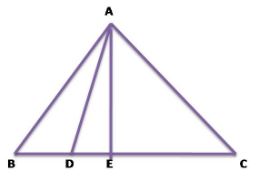
AD2 = AE2 + DE2
⇒ AD2 = 3a2/4 + a2/36
⇒ AD2 = 28a2/36
⇒ AD2 = 7a2/9
⇒ 9 AD2 = 7a2
⇒ 9 AD2 = 7AB2
Question : 16:In an equilateral triangle, prove that three times the square of one side is equal to four times the square of one of its altitudes.
Answer :
Let a is the length of the side of equilateral triangle and AE is the altitude.
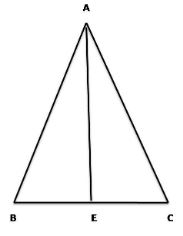
Now in triangle ABC,
From Pythagoras Theorem
AB2 = AE2 + BE2
⇒ a2 = AE2 + (a/2) 2
⇒ AE2 = a2 – a2/4
⇒ AE2 = 3a2/4
⇒ 4AE2 = 3a2
⇒ 4*(square of altitude) = 3*(square of one side)
So, three times the square of one side is equal to four times the square of one of its altitudes.
Question : 17:Tick the correct answer and justify: In Δ ABC, AB = 6√3 cm, AC = 12 cm and BC = 6 cm. The angle B is:
(A) 120° (B) 60° (C) 90° (D) 45°
Answer :
Given, AB = 6√3 cm, AC = 12 cm and BC = 6 cm
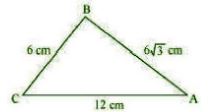
AC = 122 = 144
BC = 62 = 36
Now, AB2 + BC2 = 108 + 36
= 144 = AC2
The sides are satisfying the Pythagoras triplet in ΔABC.
Hence, these are the sides of a right angle triangle.
So, ∠ B = 90° Hence, option (C) is the correct answer.

